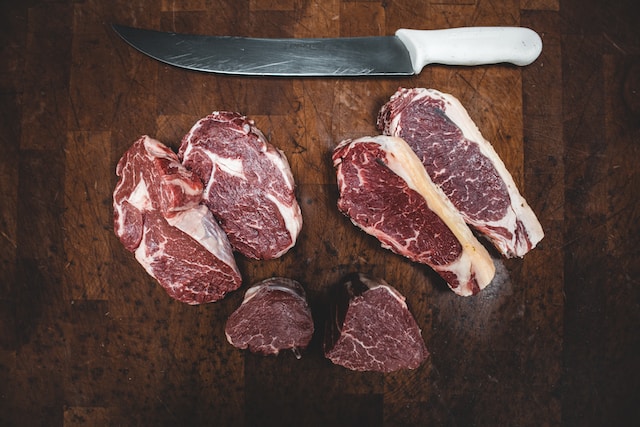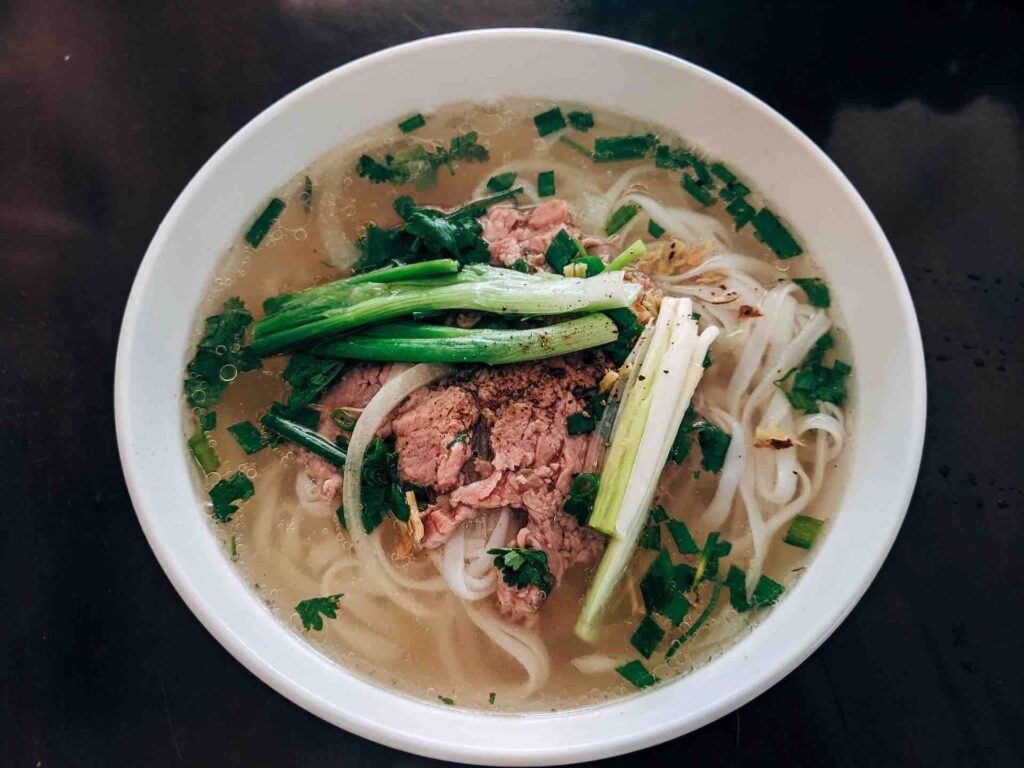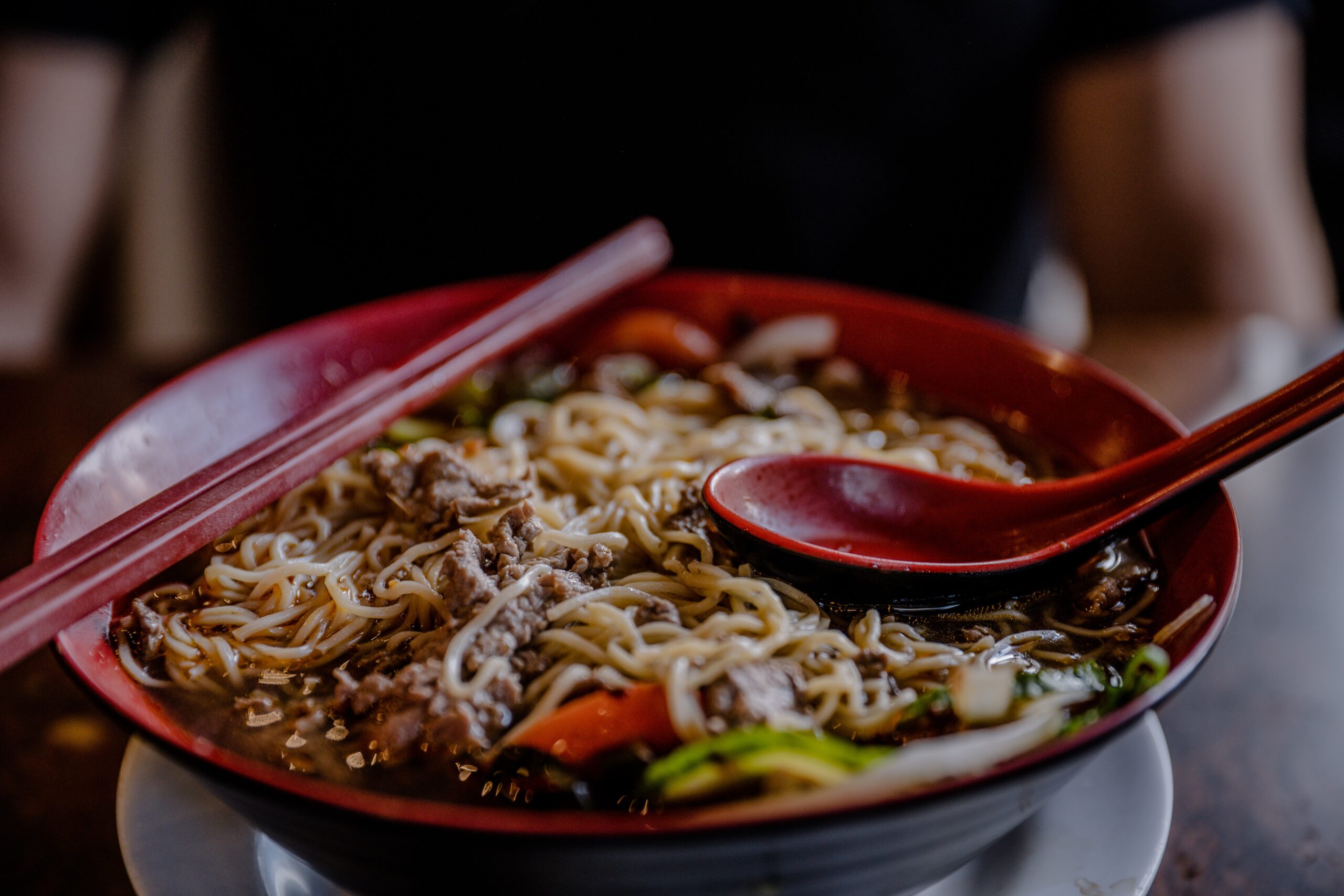Have you ever tasted a bowl of beef Pho tai chin? This beloved Vietnamese rice noodle soup dish has a captivating history and an irresistible allure that has captivated people around the world. This pho dish, with its tender slices of beef and aromatic broth, holds a special place in Vietnam’s culinary culture.
Originating from humble beginnings, Phở, a traditional Vietnamese rice noodle soup, has grown into a global sensation. Its rise to international fame can be attributed to its unique blend of flavors and textures that leave taste buds craving for more. But what makes this dish, known for its vermicelli noodles and Vietnamese beef stew, so special?
From its roots in Vietnamese cuisine to its ability to bring people together over a steaming bowl of phở, join us as we uncover the secrets behind the enduring appeal of this traditional rice noodle soup, pho tai chin.
So grab your chopsticks and get ready for a mouthwatering journey through the world of phở tai chin, a delicious rice noodle soup. Whether you’re craving beef stew or a tasty banh mi, this blog post has got you covered.
The Key Ingredients for Authentic Pho Tai Chin
It’s all about the perfect combination of flavors and textures. Let’s dive into the essential ingredients, such as chicken, beef meatballs, and tripe, that make this dish truly authentic.
Elevating the Flavor with Spices
Spices play a crucial role in creating the distinct taste of Vietnamese beef stew, pho. Two key spices, star anise and cinnamon, take center stage. These aromatic spices infuse the rice noodle soup broth with their warm and earthy flavors, giving it a rich and complex taste.
Enhancing with Fresh Herbs
Fresh herbs are an integral part of any rice noodle soup, specifically pho, adding brightness and freshness to every bite. Fragrant Thai basil, crisp bean sprouts, and zesty cilantro bring a burst of flavor while balancing out the richness of the broth. Whether it’s chicken or beef meatballs, these herbs elevate the taste of the beef stew.
The Power of Pho Garnishes
No bowl of Vietnam’s rice noodle soup, is complete without its array of garnishes. Sliced onions add a subtle sweetness to each spoonful while contributing a satisfying crunch. Hoisin sauce, with its slightly sweet and savory profile, adds depth to the overall flavor profile of this traditional dish. Whether it’s made with chicken (for chicken pho) or beef meatballs, these essential pho garnishes enhance the deliciousness of pho.
Step-by-Step Recipe for Homemade Pho Tai Chin
Follow our easy-to-follow recipe to make delicious pho, a traditional rice noodle soup from Vietnam, at home. Learn how to create a flavorful broth for your homemade pho and discover tips and tricks for achieving tender beef slices, including tripe and rare steak, in your homemade pho.
Creating a Flavorful Broth
- Start by simmering beef bones, onions, ginger, and spices in a large pot filled with water to make a flavorful base for your rice noodle soup or vegetarian pho.
- Allow the chicken pho or beef pho broth to cook on low heat for several hours to extract all the flavors in this rice noodle soup, also known as banh pho.
- Skim off any impurities that rise to the surface while simmering the beef pho and chicken pho broth for the rice noodle soup. Don’t forget to add the pho garnishes.
- Strain the beef pho broth through a fine-mesh sieve or cheesecloth to remove any solids.
Achieving Tender Beef Slices
- Freeze your beef cuts for about 30 minutes before slicing them thinly against the grain for a perfect topping of rare steak on your delicious rice noodle soup.
- This technique ensures tender beef slices that will melt in your mouth when added to the hot noodle soup broth.
Serving Your Pho
- Cook beef pho rice noodles according to package instructions and divide them into serving bowls for a delicious soup.
- Top the noodles with the thinly sliced beef and pour hot soup broth over them to create a delicious sm soup.
- Garnish your noodle soup with some sprouts, Thai basil, lime wedges, and jalapenos for added sm flavor.
- Serve vegetarian pho as an alternative by replacing beef with sm tofu or sm mushrooms.
Choosing the Best Cuts of Beef for Pho Tai Chin
Understanding which cuts of beef are ideal for making some pho is essential to creating a delicious and flavorful beef stew. Here, we’ll explore the characteristics and flavors of different beef cuts commonly used in pho, as well as provide tips on selecting high-quality beef that will enhance your dining experience.
- Beef Cuts: Pho tai chin typically features a combination of tender rare steak (sach) and brisket. These cuts offer distinct textures and flavors that complement each other in this traditional dish.
- Rare Steak (Sach): Thinly sliced rare steak adds tenderness and a rich beefy flavor to pho. The meat should be marbled with fat, ensuring it remains juicy when cooked briefly in the hot broth.
- Brisket: Brisket is another popular choice for pho tai chin due to its hearty texture and robust flavor. When cooked slowly, it becomes melt-in-your-mouth tender, infusing the broth with its savory essence.
- Additional Options: While sach (rare steak) and brisket are the mainstays of pho tai chin, you can also experiment with other beef cuts or variations:
- Steak: Some individuals prefer using thicker slices of steak instead of sach for a heartier bite.
- Beef Meatballs: Adding homemade or store-bought beef meatballs can introduce an extra burst of flavor to your pho.

By carefully selecting high-quality beef cuts like sach (rare steak) and brisket, you’ll ensure that your pho is packed with succulent flavours. Whether you stick to tradition or add your own twist with alternative options like steak or meatballs, these choices will contribute to an unforgettable bowl of Vietnamese goodness.
Tips for Ordering Pho Tai Chin at Restaurants
There are a few insider tips that can help you get the best version of this delicious dish. Whether you’re a pho connoisseur or trying it for the first time, these tips will ensure a satisfying dining experience.
Discover Common Variations and Additions
Pho tai chin may have variations or additions, depending on the restaurant. Here are some common ones you can explore:
- Bone marrow: For an added richness and depth of flavor, some places offer bone marrow as an option.
- Extra meat: If you’re craving more protein, ask for extra slices of rare beef (tai), rare steak or well-done brisket (chin).
- Beef balls: Some restaurants include beef balls in their pho for added variety.
Get Insider Tips from Restaurant Staff
Don’t be afraid to engage with the restaurant staff and seek their recommendations when ordering pho tai chin. They often have insider knowledge about popular combinations or unique offerings that can elevate your dining experience.
So next time you’re at a restaurant craving a bowl of pho tai chin, remember these tips to ensure a customized and flavorful meal that satisfies your taste buds. Enjoy!
Decoding Menus and Pronunciation Guide for Pho Tai Chin
Navigating through menus can be a breeze when you understand the common terms associated with pho tai chin dishes. Not only will this knowledge help you order with confidence, but it will also prevent any confusion or miscommunication. Let’s dive into some key points to keep in mind when exploring a pho menu.
Pronunciation Guide
To ensure you pronounce your order correctly, follow this simple guide:
- Pho is pronounced as “fuh.”
- Tai is pronounced as “tie” (rhymes with sky).
- Chin is pronounced as “chin” (rhymes with pin).
Now that we have the pronunciation covered, let’s move on to understanding the components of pho tai chin.
Identifying Noodles, Meats, and Garnishes
When scanning a pho tai chin menu, here are some terms you may come across:
- Noodles: The most common type of noodle used in pho is rice noodles. They are thin and translucent.
- Meat: Pho tai refers to the thinly sliced rare steak that is cooked by the hot broth when served.
- Broth: A flavorful soup made from simmering various ingredients like bones, spices, and herbs.
- Garnishes: These are additional toppings that enhance the flavors of your pho. Some popular options include:
- Bean sprouts
- Fresh herbs like basil, cilantro, and mint
- Lime wedges
- Sliced chili peppers
- Hoisin sauce
- Sriracha sauce
By familiarizing yourself with these terms, you’ll be able to confidently explore different variations of pho tai chin dishes without feeling overwhelmed by the menu.
So next time you find yourself at a restaurant craving a bowl of delicious pho tai chin, you’ll be well-equipped to order like a pro and enjoy every mouthful.
Embracing the Delightful Experience of Pho Tai Chin
In conclusion, embracing the delightful experience of Pho Tai Chin is an absolute must for any food lover. The key ingredients in this authentic Vietnamese dish create a harmonious blend of flavours that will tantalize your taste buds. By following a step-by-step recipe, you can even recreate this culinary masterpiece at home.
It’s important to opt for tender and flavorful options. This ensures that each bite is a succulent delight. Whether you’re dining at a restaurant or ordering takeout, our tips will help you make informed choices and savor the true essence of this dish.
Decoding menus and mastering pronunciation may seem daunting, but with our guide, you’ll navigate through any restaurant menu like a pro. Don’t be afraid to try new variations or experiment with different toppings to personalize your bowl of Pho Tai Chin.
To fully immerse yourself in the world of Pho Tai Chin, we encourage you to explore its cultural significance and history. By understanding the origins and traditions associated with this beloved dish, you’ll gain a deeper appreciation for its flavors and craftsmanship.
So what are you waiting for? Grab your chopsticks and embark on an unforgettable journey through the aromatic wonders of Pho Tai Chin. Whether you’re enjoying it at a local eatery or preparing it in your own kitchen, let this culinary adventure transport your senses to Vietnam.
FAQs
Q: Can I substitute beef with other proteins?
A: While traditionally made with beef, some restaurants offer alternative protein options such as chicken or tofu. However, remember that these substitutions may alter the dish’s flavour profile.
Q: Is there a vegetarian version available?
A: Yes! Vegetarian versions of Pho Tai Chin can be found at select restaurants, where they use vegetable broth instead of beef broth and substitute the beef with tofu or other plant-based proteins.
Q: Are there any gluten-free options for Pho Tai Chin?
A: Many restaurants offer gluten-free versions of Pho Tai Chin by using rice noodles instead of wheat-based noodles. However, it’s always best to check with the restaurant beforehand to ensure their ingredients are suitable for your dietary needs.
Q: Can I customize the toppings in my Pho Tai Chin?
A: Absolutely! Pho Tai Chin is highly customizable, allowing you to add your preferred toppings such as bean sprouts, basil leaves, lime wedges, and various sauces like hoisin or sriracha. Feel free to experiment and find your perfect combination.
Q: How can I make my Pho Tai Chin spicier?
A: If you enjoy a spicy kick, you can request additional chili peppers or hot sauce at the restaurant. At home, you can adjust the spice level by adding more chili flakes or hot pepper sauce to your homemade broth.
Heya! I’m Tony, Phuong’s youngest brother, the owner and head chef of VietQ Foods. Like my sister, I grew up with a love for Vietnamese food. We were both brought up with eating some of the best Vietnamese dishes mustered up by our parents and extended family. While I’ve always loved the food, it was only when I travelled through Vietnam in my formative years that changed my whole perspective and made me really appreciate the cuisine.
Now, I enjoy spending my time eating, cooking, and writing about everything to do with Vietnamese food.






